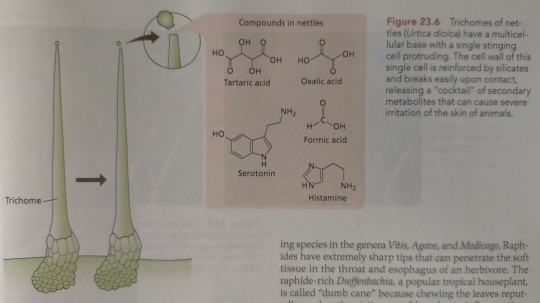#Tartaric Acid
Explore tagged Tumblr posts
Text
The cell walls of these hollow, needlelike trichomes are reinforced with glass (silicates) and filled with a nasty "cocktail" of histamine, oxalic acid, tartaric acid, formic acid, and serotonin (Figure 23.6), which can cause severe irritation and inflammation.

"Plant Physiology and Development" int'l 6e - Taiz, L., Zeiger, E., Møller, I.M., Murphy, A.
#book quotes#plant physiology and development#nonfiction#textbook#cell walls#plant cells#glass#silicate#stinging nettle#urtica dioica#trichomes#histamine#oxalic acid#tartaric acid#formic acid#serotonin#irritation#inflammation
2 notes
·
View notes
Text
Tartaric Acid Prices, News, Monitor, Analysis & Demand
In the third quarter of 2024, the North American market for Tartaric acid experienced a mixed performance, marked by significant price fluctuations, particularly in the USA.
#Tartaric Acid#Tartaric Acid Price#Tartaric Acid Prices#Tartaric Acid Pricing#Tartaric Acid News#Tartaric Acid Price Monitor#Tartaric Acid Database#Tartaric Acid Price Chart#Tartaric Acid Trend#Tartaric Acid Market Price#Price of Tartaric Acid#Market Price for Tartaric Acid#Tartaric Acid Bulk Price#Tartaric Acid Price in United States of America#Tartaric Acid Price in USA#Tartaric Acid Price in China#Tartaric Acid Price in Germany#Tartaric Acid Price in Japan#Tartaric Acid Price in Korea#Tartaric Acid Demand#Tartaric Acid supply
1 note
·
View note
Text

TSRNOSS. Page 180.
#tartaric acid#isomers#DNA#antigenicity#calcium deficiency#immunoglobulins#mercaptoethanol#antibody#disulphide bridges#Van Der Waal forces#antigen#kinetics#nose length#enteric bacteria#muramyl dipeptide#vitamin D deficiency#manuscripts#satyendra sunkavally#notebooks#diaries#cursive#handwriting
0 notes
Text
Tartaric Acid Prices | Pricing | Trend | News | Database | Chart | Forecast
Tartaric Acid a naturally occurring organic acid found in various plants, particularly grapes, plays a crucial role in the food and beverage industry, particularly in winemaking and baking. The prices of tartaric acid have witnessed fluctuations due to several factors, including raw material availability, production costs, market demand, and international trade dynamics. Understanding these pricing trends is essential for manufacturers, consumers, and businesses involved in related sectors.
Over the past few years, the demand for tartaric acid has been driven primarily by the growing wine industry, particularly in regions such as Europe, North America, and Australia. As consumer preferences shift toward natural and organic products, the use of tartaric acid in winemaking as a stabilizing agent has gained popularity. This increase in demand has contributed to rising prices, as producers strive to meet the needs of an expanding market.
Get Real Time Prices for Tartaric Acid: https://www.chemanalyst.com/Pricing-data/tartaric-acid-1126
The production of tartaric acid is closely linked to the grape harvest, which occurs annually. As the availability of grapes fluctuates from year to year due to climate conditions, the supply of tartaric acid can be impacted. For instance, adverse weather conditions such as droughts or excessive rainfall can reduce grape yields, leading to a scarcity of raw materials. This scarcity often results in higher prices for tartaric acid, as manufacturers may face increased production costs and limited access to quality raw materials.
Another significant factor influencing tartaric acid prices is the rising cost of production. The extraction and processing of tartaric acid involve various steps, including the collection of grape byproducts, purification, and crystallization. Any increase in labor costs, energy prices, or transportation expenses can affect the overall production cost, leading to higher prices for the end product. Additionally, the introduction of stringent environmental regulations may necessitate investments in cleaner technologies, further driving up costs.
Market dynamics also play a pivotal role in determining tartaric acid prices. As the global market becomes more interconnected, international trade agreements and tariffs can significantly impact pricing structures. For example, countries that rely heavily on imports for tartaric acid may face increased costs due to tariffs or trade disputes. Conversely, regions with abundant grape production and established manufacturing facilities may benefit from lower prices, creating a competitive advantage.
Moreover, the increasing popularity of tartaric acid in other industries, such as pharmaceuticals and cosmetics, has broadened its market reach and contributed to price variations. In pharmaceuticals, tartaric acid is used as an excipient in the formulation of various medications. Its role in enhancing the stability and efficacy of certain drugs has led to a growing demand, further influencing market prices. In cosmetics, it serves as a pH regulator and stabilizer in various formulations, reflecting the compound's versatility and expanding application range.
Consumer preferences also impact tartaric acid pricing. As more individuals seek natural ingredients in their food and beverages, the demand for products containing tartaric acid is likely to increase. This growing awareness among consumers can drive prices up, as manufacturers prioritize sourcing high-quality, natural ingredients to meet consumer expectations. Additionally, the rise of e-commerce and online shopping has made it easier for consumers to access specialty products, potentially leading to increased competition among suppliers and influencing pricing strategies.
Regional variations in tartaric acid prices are also noteworthy. In areas where grape production is abundant, such as California and Bordeaux, prices may remain relatively stable due to the consistent supply of raw materials. In contrast, regions with limited grape production may experience higher prices due to transportation costs and reliance on imports. These regional dynamics highlight the importance of understanding local market conditions when analyzing tartaric acid prices.
In recent years, the COVID-19 pandemic has further complicated the tartaric acid market. Supply chain disruptions, labor shortages, and increased shipping costs have created challenges for producers and suppliers alike. These factors have led to volatility in prices, as businesses navigate the complexities of a changing market landscape. As the global economy gradually recovers, it remains to be seen how these challenges will influence future pricing trends.
Looking ahead, the outlook for tartaric acid prices will depend on various factors, including the recovery of the global economy, the stability of grape harvests, and evolving consumer preferences. As sustainability becomes a more pressing concern for consumers and businesses alike, the demand for eco-friendly and organic products may continue to shape pricing dynamics in the tartaric acid market. Producers that can adapt to these changes by prioritizing sustainable practices and sourcing high-quality raw materials may find opportunities for growth even in a competitive environment.
In conclusion, the pricing of tartaric acid is influenced by a complex interplay of factors, including supply and demand dynamics, production costs, and regional market variations. As the global market continues to evolve, staying informed about these trends will be essential for stakeholders in the industry. Understanding the underlying causes of price fluctuations can help businesses make strategic decisions, ensuring they remain competitive in a rapidly changing landscape. Whether through strategic sourcing, investment in sustainable practices, or adapting to consumer preferences, navigating the tartaric acid market requires a keen understanding of both local and global influences.
Get Real Time Prices for Tartaric Acid: https://www.chemanalyst.com/Pricing-data/tartaric-acid-1126
Contact Us:
ChemAnalyst
GmbH - S-01, 2.floor, Subbelrather Straße,
15a Cologne, 50823, Germany
Call: +49-221-6505-8833
Email: [email protected]
Website: https://www.chemanalyst.com
#Tartaric Acid#Tartaric Acid Price#Tartaric Acid Prices#Tartaric Acid Pricing#Tartaric Acid News#Tartaric Acid Price Monitor
0 notes
Text

Sorbitan Monooleate is widely valued for its role in stabilizing and improving product formulations. Found in food, cosmetics, and medicines, it enhances texture, consistency, and performance. Its compatibility with various ingredients ensures efficient applications, meeting industry demands for high-quality and reliable solutions. Sorbitan Monooleate is essential for creating products that combine functionality with superior quality. If you’re looking for a reliable supplier of Sorbitan Monooleate, Spell Organics offers high-quality products tailored to meet your industrial needs. For More Information Visit : https://spellorganics.com/
#Diacetyl Tartaric Acid Ester of Mono and Diglycerides#Sorbitan Monooleate#Sodium stearoyl lactylate#Lactic Acid Esters of Mono and Diglycerides#Citric Acid Esters of Mono and Diglycerides#cosmetics
0 notes
Text
(+)-O,O’-Di-p-toluoyl-D-tartaric Acid | CAS #: 32634-68-7 | Axios Research

(+)-O,O’-Di-p-toluoyl-D-tartaric Acid from Axios Research in Europe. Axios Research provides the best quality (+)-O,O’-Di-p-toluoyl-D-tartaric Acid. Visit: https://www.axios-research.com/products/o-o-di-p-toluoyl-d-tartaric-acid
0 notes
Text
Tartaric Acid Prices Insights, Tracking, News, Trends & Forecast | ChemAnalyst

Tartaric acid prices, reflecting the cost of this versatile compound, are subject to fluctuations influenced by various factors such as global market dynamics, industrial demand, and production costs. Understanding these price movements entails a comprehensive analysis of supply and demand dynamics, raw material availability, and macroeconomic indicators.
The pricing of tartaric acid is significantly influenced by the balance between supply and demand within industries such as food and beverage, pharmaceuticals, and cosmetics. Tartaric acid, valued for its properties as a food additive, buffering agent, and chelating agent, finds extensive application in products ranging from wines and soft drinks to pharmaceutical formulations and cosmetics. Disruptions in the supply chain, such as fluctuations in raw material availability, production capacity, or transportation logistics, can impact the availability and cost of tartaric acid, thereby influencing its market price.
Industrial demand plays a crucial role in determining tartaric acid prices. Industries such as food and beverage rely heavily on tartaric acid for its role in adjusting acidity, stabilizing colors, and enhancing flavors in various products. Pharmaceutical and cosmetic sectors also utilize tartaric acid for its properties as an excipient and pH adjuster. Fluctuations in demand from these sectors, influenced by factors such as consumer preferences, regulatory approvals, and technological advancements, can lead to price volatility for tartaric acid.
Get Real-Time Tartaric Acid Prices: https://www.chemanalyst.com/Pricing-data/tartaric-acid-1126
Raw material costs significantly impact tartaric acid prices. The price of raw materials such as tartaric acid salts, which are commonly used in tartaric acid production, can fluctuate due to changes in global supply and demand dynamics, agricultural practices, and energy costs. Any significant increase in raw material costs can translate into higher production costs for tartaric acid manufacturers, thereby exerting upward pressure on prices.
Macroeconomic indicators, such as GDP growth, consumer spending, and industrial output, can indirectly affect tartaric acid prices by influencing overall demand for products containing tartaric acid. Economic expansions tend to drive demand for tartaric acid-intensive products such as food and beverages, pharmaceuticals, and cosmetics, thereby supporting higher prices. Conversely, economic downturns or uncertainties may lead to reduced demand and downward pressure on tartaric acid prices.
Regulatory changes and quality standards also play a role in shaping tartaric acid prices. Government regulations on food additives, pharmaceutical excipients, and cosmetic ingredients can impact production costs and market access for tartaric acid manufacturers. Compliance with these regulations may require investments in research, testing, and quality control measures, influencing pricing dynamics.
Looking ahead, several factors are expected to continue influencing tartaric acid prices. Continued growth in sectors such as food and beverage, pharmaceuticals, and cosmetics, coupled with increasing demand for functional ingredients and performance additives, is likely to drive sustained demand for tartaric acid. Moreover, advancements in formulation technology, changes in consumer preferences, and shifts in global trade dynamics could lead to changes in market dynamics and price levels for tartaric acid.
In conclusion, tartaric acid prices are subject to a complex interplay of factors including supply and demand dynamics, industrial trends, raw material costs, regulatory changes, and macroeconomic indicators. Stakeholders in industries reliant on tartaric acid, such as food and beverage, pharmaceuticals, and cosmetics, must closely monitor these factors to anticipate price movements and make informed decisions. As industries evolve and regulatory requirements change, navigating the dynamic landscape of tartaric acid pricing will remain a key challenge for industry participants.
Get Real-Time Tartaric Acid Prices: https://www.chemanalyst.com/Pricing-data/tartaric-acid-1126
ChemAnalyst
GmbH — S-01, 2.floor, Subbelrather Straße,
15a Cologne, 50823, Germany
Call: +49–221–6505–8833
Email: [email protected]
Website: https://www.chemanalyst.com
0 notes
Text
Diacetyl Tartaric acid ester of Mono-and diglycerides commonly known as DATEM. DATEM has strong emulsification , dispersing and aging resistance effects , Widely used in food , bakery . butter , syrup etc .When the flour is of good quality and the operation is perfect, the volume of bread made by DATEM is larger than that of other emulsifiers.
0 notes
Text
Unend Departure Dinner
Celebrating the maiden voyage of the Ship
Courtesy of Chef Quino Del Belsaban (chef) and sous-chefs Voro and Mikelord
We will tonight celebrate the commencement of the journey, and it’s our pleasure this evening to treat you all to a very special and unique singular meal, compliments of the Cosmological Consortium’s Highest Light subcommittee.

We begin with ephemera of mineralflower enclosing lavenderwater-infused mirrorhawk mousse, dusted with riftgrass pollen, nestled on a sprouted microbloom tuft, crowned with edible Serapha Nebulaflorum.

And of course our signature cocktail tonight the Aurora Prismatica, exquisite Empyrean lavender and silk cordial, layered with zephyr of eldermanflower, misted with Alpinian plume of Verdure and lightly smoked with charcoal of Sequestrian hacklethorn. I personally recommend you enjoy it on the rocks – perhaps unorthodox, but just trust us on this one.

Buloga pearl caviar tartare, accompanied by shaved roast of sloe, crowned with frosted Ebonreef truffle, drizzled with 100-traversal-aged prang syrup and garnished with chinchona leaf. Enjoy.

The palate-cleansing salad is up next. My friends, a medley of crisp frisée, tender mini prunus hearts, and heirloom rubus misted with essence of blackened citrus of elderthief, sprinkled with delicious and nutritious high-altitude breadmoss and garnished with greens from the gardens of Gloria. Please enjoy.

Our main entree, my friends: sovereign spice-seared filet of Vildefeluvian lake grouper, ladled with reduction of burk buranah, brushed with crushed pistachio and golden salt, served atop a bed of rare black macrograin sourced from the marshes of Ackute. Dig in.

Miravette Reserve, an aromatic honeylight wine from the Highest Light? Quite delicate, notes of straw and almond, very well-balanced, very intriguing

And for our grand finale, exquisite bombe of blonded and blued chocolate mother-of-mica, encased in a delicate wind-woven sugar dome, decorated with self-caramelizing tufted sugar frond, rosewater foam, and edible silverleaf confetti, and finished of course with a touch of our most rare and fine melt-velvet orchid extract. It’s been our pleasure to serve you this evening everyone. Thank you so much.
Ingredients (by request)
Hors d'oeuvre (Un inspired)
Ephemera of mineralflower - phyllo pastry blossoms lightly brushed with strawberry syrup and sprinkled with gold decorator sugar “minerals”.
Lavenderwater-infused mirrorhawk mousse - salmon cream-cheese mousse (go very easy on the lemon juice) with chili flakes, and smoked paprika, partially lavender tinted
Riftgrass pollen - paprika and a hint of turmeric, edible glitter mica
Sprouted microbloom tuft - ball of sprouts, local wildflower micro blossoms
Serapha Nebulaflorum - Rosemary blossoms, saffron, cornflower petals, and marigold petals
Cocktail (Fold inspired)
Empyrean lavender and silk cordial -
lychee mogu mogu drink(as base silk cordial - can be blended smooth if needed), strong chilled butterfly pea flower tea (as lavender cordial - spoon gently over appears lavender/indigo in basic conditions)
Zephyr of eldermanflower - small amount of Plum Soju spooned gently on top (mildly acidic, turns top of butterfly tea magenta/violet) substitute a tiny amount of white peach or other clear fruit juice of your choice for a non-alcohol version
Alpinian plume of Verdure - Blossoming heather sprig)
Charcoal of Sequestrian hacklethorn - torched cinnamon (not recommended, maybe a cherry wood? smoking not essential for how sweet and floral this cocktail is)
On the rocks - giant ice cubes
Appetizer (Fold inspired)
Buloga pearl caviar tartare - chia caviar with butterfly-tea dyed tapioca pearls served on a base of crème fraîche (alternatively could try black lumpfish caviar too, if available)
Shaved roast of sloe - if sloe = slow thinly shaved oil and sea-salt roast purple potato, if sloe = the gin plum, sliced and roasted umeboshi red plum for garnish (both plum and potato used)
Frosted Ebonreef truffle - crunchy dried shiitake snack mushroom frosted with silver edible mica glitter,
100-traversal-aged prang syrup - balsamic vinegar, fresh raspberry and apricot jam reduction with a touch of soy sauce (strained)
Chinchona leaf - shiso leaf
Salad (Un inspired)
Medley of crisp frisée - a base of curly endive and pea shoots
Tender mini prunus hearts - almonds and dried apricot cut into hearts (both in prunus family),
Heirloom rubus - raspberries and blackberries
Essence of blackened citrus of elderthief - sugared and caramelized blood orange and mini clementine slices, scant raspberry balsamic vinaigrette
High-altitude breadmoss - French bread triangles brushed with olive oil and coated with dried parsley and dill (needs work to become more tasty - try garlic bread triangles and a lighter dusting of herbs)
Greens from the gardens of Gloria - parsley and “spring mix” greens.
Main (Fold inspired)
Sovereign spice-seared filet of Vildefeluvian lake grouper - pacific cod with salt, pepper and old bay, pan seared in vegetable oil and basted with butter
Reduction of burk buranah - supposed to be a cab-sav beurre blanc, but used a Béarnaise instead
Crushed pistachio - crushed pistachio (blanched to remove brown hulls) Golden salt - golden decorator sugar because it looked pretty, but could also try a turmeric-ginger-garlic golden salt,
Rare black macrograin sourced from the marshes of Ackute - black rice
Wine (Un inspired)
Miravette Reserve - 2020 Gérard Bertrand Orange Gold (clean and citrusy, good with fish)
Dessert (Un inspired)
Exquisite bombe of blonded and blued chocolate mother-of-mica - Mirrorhawk pearl of white chocolate strawberry Lindt rolled in blue/yellow cake sprinkles, on a split lemon madeleine shell with blue and yellow chocolate button and crème fraîche ganache
Delicate wind-woven sugar dome - blue cotton candy
Self-caramelizing tufted sugar frond - punished and caramelized marshmallows on a strawberry pocky stem with strawberry syrup and golden sugar embellishments
Rosewater foam - pink lychee gel foam
Edible silverleaf confetti - oregano leaves dusted with silver edible mica glitter
Melt-velvet orchid extract - strawberry vanilla syrup
Enjoy!
189 notes
·
View notes
Text
Figure 17.21 shows the two pairs of mirror images of this compound. Structures (a) and (b) are nonsuperimposable mirror images and, therefore, they are a pair of enantiomers. Structures (c) and (d) are also mirror images, but they are superimposable if they are rotated to the appropriate orientation. Therefore, (c) and (d) are not different molecules; they are the same molecule, just oriented differently. Because (c) and its mirror image (d) are superimposable, they are the same molecule and achiral.

Thus, even though (c) has two stereocentres, it is achiral. Its plane of symmetry is shown in figure 17.21. The stereoisomer of tartaric acid represented by (c) or (d) is called a meso compound, defined as an achiral compound with two or more stereocentres.
"Chemistry" 2e - Blackman, A., Bottle, S., Schmid, S., Mocerino, M., Wille, U.
#book quotes#chemistry#nonfiction#textbook#tartaric acid#dihydroxybutanedioic acid#enantiomers#chirality#meso compound#mirror image
0 notes
Text
What candy the fellowship likes
Aragorn:
-I don’t think he is a candy man, but he does have a sweet tooth
-Man loves a good cake, especially chocolate
-He also likes DOTS like a fucking weirdo (sorry if you like those)
Legolas:
-Legolas definitely eats the most sour candy with a straight face
-Snorts tartaric acid
-Actual grave mouth
-It’s kind of concerning
Gimli:
-Eats the spicy candy
-Not because he particularly likes it
-But he wants to prove to himself that he can take it
-Face goes really red, doesn’t handle spice well
-Also loves grandma candy, especially butterscotch
Boromir:
-Eats candy like a little kid with no taste buds and just wants the big swirly lollipop because it looks cool
-Seriously those things have no flavor
-Those paper slips with the colorful sugar dots that you use to decorate gingerbread houses
-If he’s feeling spicy he will have rock candy as a special treat
Frodo:
-Gummy boy
-But the old fashioned ones that sit like rocks in your stomach
-Like the one that looks like eggs
-And those circus peanuts; would eat a packing peanut for science
Sam:
-I don’t think this hobbit has much of a sweet tooth
-Probably likes gourmet dark chocolate and a cheese platter
-Chocolate covered strawberries will put a smile on his face though
Merry:
-Likes the nutty chocolates
-And nougat; would swallow a Three Musketeers whole
-Really likes toffee as well
Pippin:
-As long as it is labeled as candy he will eat it
-Keep any fake food away from him in general because he will eat it even once he realizes it’s fake to prove a point
-Goes feral for a Nerds Rope
-I also think he loves carrot cake with the cream cheese icing
Gandalf:
-Jelly beans, but doesn’t care if they taste bad
-“hmm *smacks lips* alas! Earwax”
-I’m not comparing him to Dumbledore but he definitely would do that exact same thing ^
#boromir#aragorn#legolas#lord of the rings#lotr#lotr fellowship#frodo baggins#gimli son of gloin#lotr preferences#merry and pippin#lotr headcanons#samwise gamgee#meriadoc brandybuck#peregrin took#gandalf#gandalf the grey#the lord of the rings#headcanon#prefrences#I don’t know if it’s preferences or headcanon#just for fun
123 notes
·
View notes
Note
Which do you think is a better concept, sanitized ink(and sensitization in general) or the fuzzy ooze?
I feel like in order to say which is "better" we need to break it down into parts.
In terms of the general theming and aesthetics, i think that sanitization clears the Fuzzy Ooze. Like just look at this.



The sickly green and blue. The darked eyeballs. It looks so acidic and gross, and i like that. It really gives off the vibe of a poison and something you don't wanna touch.
Compare that to Fuzzy Ooze and it's just... purple trippy ink and fur. I mean it looks cool, i like the effect, but it doesn't hit the same as the Sanitized Ink.


Now the actual effects? I'm gonna be real. I don't realllyyyyy like either of them to an extent.
Oh wow, Sanitized Ink is brainwashing goo that removes memories and makes you into a mind controlled zombie that follows the orders of Tartar, how fun! Yay! So interesting... I love when the Splatoon series uses the same tired trope of "it's the thing you know, but it's EVIL NOW!!!!!!!" wow... Really creative huh Nintendo... I'm sure that it won't cause a wave of millions of people to not properly look into the stories and just take them at the surface level and just say that everything is the same affliction..... yay.... ugh... i hate everything...



I will say though, i like the sort of medical undertones of Sanitized Ink and everything to do with Acht is very interesting and cool! Although in Side Order they kinda fucked it up by saying that Acht was forced to make music for Tartar due to the goop instead of being a thing where Acht wanted to make music without the doubts in their head. So... yeahhhh... I don't know how to feel about having YET ANOTHER thing in the Splatoon series that's just "oh it's this evil thing that makes stuff evil!! ooooo!!! brainwashing oooo!!!!"
I'm tired of it. I had enough. STOP!!!! ENOUGH NINTENDO!!!!!!! YOU'RE NOT SMART! YOU'RE NOT INTERESTING! BE MORE CREATIVE! DO BETTER!!!! IF YOU MAKE FRYE GO UNDER A SIMLIAR THING AND IF THE COMMUNITY CALLS IT BRAINWASHING YET AGAIN OOOOOOOOOOOOOOOOOOOOOOOOO HOHOHOHHOHOOO!!!!! IM GONNA RIP MY FUCKING HAIR OU-
Anyways, Fuzzy Ooze on the other hand is kinda... vague? Like really really vague. What we do know is that it makes a creature "lose their sense of self" whatever the FUCK that means i do not know. Sometimes it makes Inklings and Octolings turn into fuzzy little creatures, or it gives them weed eyes. I guess both options aren't as bad as becoming zombies. I guess....


However, i think this vagueness really opens the door for very interesting fan interpretations. I love seeing people make fuzzy versions of the characters and turning them into these feral monsters that have claws and sharp teeth, it's so fucking sick and way cooler than just "oooo brainwashing oooooo!!!! its the thing you know but EVIL!"
I would rather take a fuzzy au over a sanitization au you know? It opens the door for more creativity.
To wrap it up, i like the aesthetics and thematic undertones of Sanitized Ink, but i prefer the vague effects of the Fuzzy Ooze as it opens the door for interpretations.
Also, Nintendo, YOU BETTER EXPLAIN THE FUZZY OOZE MORE IN SPLATOON 4! THERE'S THOUSANDS OF FUZZY OCTARIANS TRAPPED IN ALTERNA! YOU GONNA TALK ABOUT THAT?!?!
#splatoon#splatoon 3#ask blog#ask me stuff#ask me anything#sanitized octoling#sanitized agent 3#fuzzy ooze#fuzzy octoling#rant post#discussion#hypno callie#octo callie#marina agitando#acht dedf1sh#acht splatoon#side order#octo expansion
51 notes
·
View notes
Text
Tartaric Acid Prices Trend | Pricing | Database | Index | News | Chart

Tartaric Acid Prices, a crucial component in various industries including food and beverage, pharmaceuticals, and cosmetics, has experienced notable fluctuations in pricing over recent years. The pricing dynamics of tartaric acid are influenced by several key factors, prominently including global supply and demand trends, raw material costs, and geopolitical developments impacting trade. As a natural product derived primarily from grapes and certain other fruits, tartaric acid's supply chain is vulnerable to variations in agricultural yields and climate conditions, which directly affect its availability and cost.
In recent times, the tartaric acid market has shown resilience amid challenges posed by climate change and fluctuating agricultural outputs. The global demand for tartaric acid remains robust, driven by its essential roles as an acidity regulator, stabilizer, and flavor enhancer in food and beverage products. Furthermore, its applications in pharmaceutical formulations as a buffering agent and in cosmetic products as an antioxidant contribute significantly to its market stability.
The pricing of tartaric acid also reflects the broader economic landscape, with macroeconomic factors influencing production costs and pricing strategies adopted by key manufacturers. As a chemical compound, tartaric acid is subject to market forces that dictate its price elasticity, often responding to shifts in consumer preferences towards natural ingredients and clean label products. Manufacturers and suppliers navigate these dynamics through strategic sourcing of raw materials and operational efficiencies to maintain competitive pricing amid market volatility.
Get Real Time Prices of Tartaric Acid : https://www.chemanalyst.com/Pricing-data/tartaric-acid-1126
Geographically, the production and consumption patterns of tartaric acid vary, with major producing regions such as Europe, South America, and Asia-Pacific playing pivotal roles in shaping global pricing trends. Regional differences in regulatory frameworks and trade policies further impact the cost structure and availability of tartaric acid in international markets. For instance, tariffs on imports or exports of tartaric acid can influence pricing strategies and market competitiveness among suppliers.
In recent years, technological advancements in manufacturing processes and sustainable practices have emerged as crucial factors influencing tartaric acid prices. Innovations in extraction techniques and recycling methods for by-products have enhanced production efficiencies, thereby mitigating cost pressures and contributing to price stabilization. Moreover, growing consumer awareness regarding environmental sustainability has prompted industry players to adopt eco-friendly practices, influencing pricing dynamics through the lens of corporate responsibility and market differentiation.
The competitive landscape of the tartaric acid market is characterized by the presence of key players leveraging economies of scale and diversified product portfolios to maintain market leadership. Strategic alliances and mergers among manufacturers aim to consolidate market share and optimize supply chain efficiencies, thereby exerting influence on pricing strategies across the industry. Additionally, quality standards and certifications play a pivotal role in establishing trust and credibility among consumers, influencing their willingness to pay premium prices for certified tartaric acid products.
Looking ahead, the future trajectory of tartaric acid prices hinges on several anticipatory factors, including advancements in agricultural practices, regulatory developments, and evolving consumer preferences for natural and sustainable ingredients. As the global economy continues to recover from the impacts of the COVID-19 pandemic, supply chain resilience and market adaptability will remain critical determinants of tartaric acid pricing dynamics. Industry stakeholders are poised to navigate these challenges through collaborative efforts and innovation-driven solutions, aiming to sustainably meet the evolving demands of diverse end-use applications.
In conclusion, tartaric acid prices reflect a complex interplay of supply chain dynamics, regulatory environments, technological innovations, and consumer trends. The resilience of the tartaric acid market underscores its essential role in multiple industries and highlights the strategic imperatives for stakeholders to adapt to changing market conditions while maintaining competitive pricing strategies. By fostering innovation and sustainable practices, the tartaric acid industry is poised to navigate future challenges and opportunities, contributing to its enduring significance in global markets.
Get Real Time Prices of Tartaric Acid : https://www.chemanalyst.com/Pricing-data/tartaric-acid-1126
Contact Us:
ChemAnalyst
GmbH - S-01, 2.floor, Subbelrather Straße,
15a Cologne, 50823, Germany
Call: +49-221-6505-8833
Email: [email protected]
Website: https://www.chemanalyst.com
#Tartaric Acid#Tartaric Acid Price#Tartaric Acid Prices#Tartaric Acid Pricing#Tartaric Acid News#Tartaric Acid Price Monitor
0 notes
Text
Now that I return once more, something I have been thinking deeply about with Dionysus—now that the grapes are ripening—is him and the grapevine. One of the beautiful ‘paradoxes’ in mythology is the way he was said to have discovered wine, but then also is the ripening force of the vine—Dionysos Veraison—as I would call him is the one that transmutes the bitter grape acids, tartaric and malic, into sweet sugars.
In order for wine to ferment, veraison must occur. In becoming a wine god, did his red fingertips touch the vine and cause it to bloom, with the cluster falling to the earth, bursting forth, and fermenting into ethanol? Did in discovering wine and creating it did he understand the way the sun and vine vitality creates the conditions necessary? Or if we follow the myth of Ampelos, did his grief make him realise the eternal gift his love’s shorn form now possess?
mythology is truly so fun. Dionysos the winemaker as a man of grief and careful understanding of a natural process—does one become what they do, if they tie themselves to it so closely?
#dragonis.txt#dionysus devotee#dionysus worship#dionysos deity#dionysos worship#paganism#hellenic paganism#pagan#hellenic pagan#hellenic polytheism#hellenic polytheist#helpol#hellenic deities#theoi#not to wax poetically but I was in the vineyard again#the grapes have bloomed and the clusters are forming#And I see him smiling so kindly…
62 notes
·
View notes